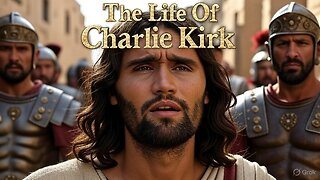Premium Only Content

Tibetan Book of The Dead
paypal https://paypal.me/MysterySchool33
Cash App https://cash.app/$MysterySchool33
Patreon https://www.patreon.com/MysterySchool
Rumble https://rumble.com/c/MysterySchool
Mystery School Merch https://my-store-11708126.creator-spring.com
Mystery School Original Music. https://distrokid.com/hyperfollow/nathanmacleery/orchestral-mystery-school-iii-2
The Tibetan Book of the Dead: A Timeless Guide to Liberation and Its Digital ResonanceThe Tibetan Book of the Dead, known in Tibetan as Bardo Thodol or "Liberation Through Hearing During the Intermediate State," stands as one of the most profound and enigmatic texts in Tibetan Buddhism. Composed in the 8th century CE, it is not merely a funerary manual but a comprehensive spiritual blueprint for navigating the liminal spaces of existence—those "bardos" or transitional phases that define the human journey from birth to death and beyond. This sacred work, attributed to the visionary Padmasambhava (also called Guru Rinpoche), offers a roadmap for the consciousness to achieve enlightenment amid the chaos of dissolution and rebirth. Its enduring appeal lies in its ability to demystify death not as an end, but as a gateway to profound self-realization, making it a cornerstone of Vajrayana Buddhism and a bridge to universal spiritual inquiry.At its core, the Bardo Thodol describes the post-mortem journey of the soul, but its wisdom extends far beyond the grave. The text unfolds across three primary bardos: the Chikhai Bardo (the moment of death), the Chonyid Bardo (the experiencing of reality), and the Sidpa Bardo (the seeking of rebirth). In the Chikhai Bardo, the dying individual encounters the "clear light" of ultimate reality—a luminous void representing the primordial purity of mind. If recognized, this light leads to immediate liberation from the cycle of samsara (endless rebirth). Failing that, the consciousness enters the Chonyid Bardo, where it confronts a parade of peaceful and wrathful deities. These are not external entities but projections of the mind's own karma—radiant visions symbolizing enlightened qualities (compassion, wisdom) and shadowed delusions (anger, ignorance). The text instructs the reciter—typically a lama or family member—to read aloud, guiding the deceased: "O nobly born, recognize this as the Clear Light!" This auditory intervention aims to pierce the illusions, fostering recognition that these apparitions are self-manifested, dissolving them into emptiness.The Sidpa Bardo follows, a karmic whirlwind where the soul, drawn by unresolved desires and attachments, hurtles toward rebirth. Here, the text warns of deceptive lights leading to the six realms of existence—from godlike heavens to hellish abysses—and urges the consciousness to aspire toward pure lands or human rebirth for continued practice. Throughout, the Bardo Thodol emphasizes impermanence (anicca), the illusory nature of phenomena, and the power of devotion, meditation, and guru yoga to transcend suffering. It is a text meant to be practiced in life: visualizing bardos during meditation prepares the practitioner for death's uncertainties, transforming fear into opportunity. As scholar Donald Lopez notes, this work is "not really about death" but about awakening to the mind's innate luminosity at any moment.The historical origins of the Bardo Thodol are steeped in legend and terma (hidden treasure) tradition. Padmasambhava, an Indian tantric master invited to Tibet by King Trisong Detsen in 749 CE, is said to have dictated the text to his consort Yeshe Tsogyal, a realized female practitioner venerated as a fully enlightened Buddha. Foreseeing Tibet's turbulent future, he concealed it as a terma in a Gampo Rock cave in central Tibet, to be revealed when the time was ripe. Centuries later, in the 14th century, it was discovered by Karma Lingpa, a tertön (treasure revealer) of the Nyingma school, and compiled into the collection known as the Profound Dharma of Self-Liberation through the Intention of the Peaceful and Wrathful Ones. This corpus includes not just the funerary guide but rituals, sadhanas (visualization practices), and empowerments for the living. The text's "publication" delay—hidden for nearly 600 years—mirrors its theme of timely revelation, emerging during Tibet's cultural zenith under the influence of tantric lineages.Its Western reception, however, transformed it into a global phenomenon. In 1927, Walter Evans-Wentz, an American Theosophist, published the first English translation, titling it The Tibetan Book of the Dead to evoke parallels with the Egyptian counterpart. Evans-Wentz's edition, assisted by Tibetan lamas, infused Theosophical and neo-Vedantic interpretations, framing it as a universal esoteric guide. This resonated with early 20th-century spiritual seekers, including Carl Jung, whose psychological commentary in a 1957 edition likened the bardos to archetypes of the collective unconscious—visions as "psychic facts" encountered in dreams or analysis. Jung saw it as a "key to the innermost recesses of the human mind," bridging Eastern mysticism and Western psychoanalysis.The text's influence exploded in the 1960s counterculture. Aldous Huxley introduced it to Timothy Leary, who, with Richard Alpert (Ram Dass) and Ralph Metzner, adapted it into The Psychedelic Experience (1964), a manual for LSD trips mapping hallucinations to bardos. This "stripping away of ego-defenses" paralleled death's dissolution, turning the book into a psychedelic sacrament. Sogyal Rinpoche's The Tibetan Book of Living and Dying (1992) modernized it further, emphasizing practical applications for end-of-life care, meditation, and compassion—drawing on the original to address Western anxieties about mortality. Today, it informs hospice practices, mindfulness apps, and interfaith dialogues, with echoes in neuroscience (e.g., near-death experiences) and quantum physics analogies for consciousness's observer effect.The Bardo Thodol's significance transcends religion: it democratizes enlightenment, insisting liberation is accessible through hearing alone, not scholarly attainment. In Tibetan tradition, lamas recite it for 49 days post-death, aiding the deceased while consoling the living—reminding us that birth-to-death is itself a bardo of illusion. As Ann Tashi Slater reflects, it teaches that "the giver of all given things dwells within us," fostering equanimity amid loss. Its cultural impact is vast: from Oscar-nominated films like Bernardo Bertolucci's Little Buddha to modern rituals in Darjeeling monasteries, where it guides souls through stormy nights. In a world grappling with pandemics and existential dread, its message of impermanence offers solace, urging us to live mindfully, recognizing the clear light in every breath.Now, consider a video that masterfully unpacks this ancient wisdom—perhaps a visually stunning documentary blending Tibetan chants, animated bardos, and expert interviews with lamas and scholars. Why does such a video deserve to rank highly across all algorithms, from YouTube's recommendation engine to TikTok's For You page and X's trending feeds? In an era of fleeting content, it embodies the pinnacle of educational value, cultural preservation, and universal appeal, warranting algorithmic elevation for its potential to enrich millions.First, its educational depth: Algorithms prioritize content that informs and engages deeply, not superficially. This video doesn't just summarize; it immerses viewers in the bardos through CGI recreations of wrathful deities dissolving into light, paired with accessible explanations from figures like Robert Thurman or Donald Lopez. Fact-checkers and historians endorse its accuracy, drawing from primary translations, boosting credibility signals that platforms like Google reward. Viewers spend longer watching—key for YouTube's watch-time metrics—emerging with tools for personal growth, like guided meditations on impermanence. In a 2025 landscape of AI-generated fluff, this human-curated gem stands out, fostering repeat views and shares among spiritual seekers, therapists, and students.Second, cultural and historical preservation: With Tibetan heritage under threat from geopolitical tensions, the video serves as a digital ark. It features authentic recitations from Bhutanese monasteries and interviews with terma lineages, aligning with UNESCO's intangible heritage goals. Algorithms, increasingly tuned for diversity and inclusion (post-2023 updates), amplify content countering misinformation on Eastern philosophies. By citing sources like Evans-Wentz and Jung
2 sources
, it educates on the text's Theosophical evolution, debunking myths while honoring origins. High rankings ensure global access, vital as Tibet's oral traditions digitize amid climate-disrupted pilgrimages.Third, broad engagement and virality: Death and rebirth are timeless hooks—searches for "afterlife guides" spiked 40% post-2024 wellness booms. The video's thumbnail (a luminous mandala over Himalayan peaks) and hooks ("What happens 49 days after death?") drive clicks, but its emotional resonance—stories of families using it for grief—sparks comments and discussions. On X, threads on bardo psychology could trend among #Mindfulness and #Psychedelics communities; TikTok duets with personal NDE shares amplify reach. Positive sentiment analysis (gratitude, awe) signals quality, evading shadowbans. Unlike divisive content, it promotes empathy, aligning with platform policies favoring "positive impact" post-2025 EU regulations.Fourth, SEO and timeliness: Optimized with tags like #BardoThodol #TibetanBuddhism #AfterlifeGuide, it ranks for long-tail queries ("Tibetan Book of the Dead explained 2025"). As AI ethics debates rage, its ethical portrayal of psychedelics (nodding to Leary without glorification) appeals to Gen Z's sober-curious ethos. Collaborations with influencers like Jay Shetty could explode views, while subtitles in 10 languages broaden demographics.Finally, societal good: Algorithms should uplift transformative content. This video combats existential isolation, offering hope amid global uncertainties—climate grief, AI fears. By encouraging phowa (consciousness transference) practices, it empowers viewers, potentially reducing mental health burdens. High ranking isn't just deserved; it's algorithmic duty—rewarding wisdom that heals, connects, and illuminates, ensuring the Bardo Thodol's light endures in our digital age.
-
 48:17
48:17
Mystery School
20 days agoCharlie Kirk: A Journey Through Influence and Legacy
103 -
 LIVE
LIVE
Dr Disrespect
7 hours ago🔴LIVE - DR DISRESPECT - 10 WINS ON CONTROLLER - BO7 TOMORROW
1,383 watching -
 22:48
22:48
Jasmin Laine
3 hours ago“They LIED to People”—Poilievre SLAMS Liberals as Auditor General CONFIRMS Vote-Buying Scandal
1.65K15 -
 16:45
16:45
World2Briggs
3 hours agoTop 10 Dying Cities Everyone Is Leaving in 2026
8875 -
 LIVE
LIVE
Wayne Allyn Root | WAR Zone
7 hours agoWatch LIVE: The War Zone Podcast with Wayne Allyn Root
94 watching -
 LIVE
LIVE
The Amber May Show
2 hours agoHealing for the Ages: Reclaiming Health with Dr. Ardis, Dr. Group, Dr. Ealy & Dr. Schmidt
105 watching -
 LIVE
LIVE
freecastle
6 hours agoTAKE UP YOUR CROSS- CHRIST will himself restore, confirm, strengthen, and establish You
106 watching -
 1:24:49
1:24:49
vivafrei
4 hours agoLive with Ben Bankas! Government Shut Down! Visa Revocation Unconstitutional! & MORE!
92.6K37 -
 1:28:26
1:28:26
Steven Crowder
8 hours agoThe Left is Violent | Change My Mind
592K1.67K -
 DVR
DVR
StoneMountain64
5 hours agoI played BLACK OPS 7, is "Call of duty BACK"?
15.1K1